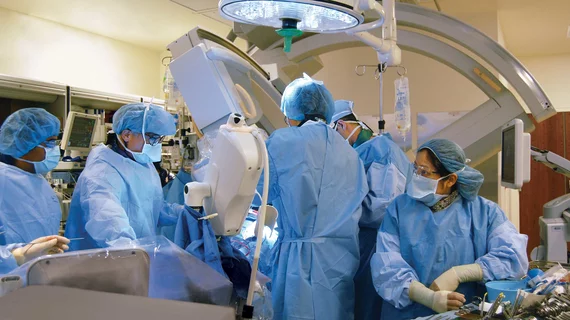Earlier interventions may boost survival when TAVR patients experience a stroke
Timely interventions and communication between cardiologists and neurologists can improve outcomes for transcatheter aortic valve replacement (TAVR) patients who experience a periprocedural stroke, according to new findings published in JACC: Cardiovascular Interventions.[1]
Acute ischemic stroke, paravalvular leak, major vascular and bleeding complications, acute kidney injury, and conduction abnormalities are the TAVR complications that concern clinicians the most. Stroke, the study’s authors noted, is perhaps the most worrisome of them all.
“Contemporary TAVR data with various platforms across the operative risk spectrum show a 30-day stroke rate ranging from 1.4% to 4.3%, and roughly half of these strokes are disabling,” wrote first author Amos Levi, MD, a cardiologist with Tel Aviv University in Israel, and colleagues.
To gain a better understanding of acute ischemic stroke complicating TAVR—or AISCT for short—Levi et al. explored data from more than 16,000 TAVR patients who underwent TAVR in Israel, Europe or North America from 2006 to 2021. AISCT was seen in 2.3% of those patients, and the median interval between TAVR and stroke was one day.
Mortality after one year was 28.9% among patients with a mild stroke, 35.9% among patients with a moderate stroke and 77.5% among patients with a severe stroke.
Tracking how each patient’s stroke was treated, the authors found that nearly 90% were managed conservatively. The remaining patients were treated with a neurointervention (NI), including 26 patients who were treated with mechanical thrombectomy (MT) and 13 patients who were treated with thrombolytic therapy (TT). The use of general anesthesia and nonfemoral access for TAVR were both associated with a higher risk of AISCT that resulted in MT or TT. AISCT patients who required MT or TT also had a higher median National Institutes of Health Stroke Scale (NIHSS) score than patients who were managed conservatively.
When excluding patients who had a mile stroke—MT or TT would typically not be considered for such patients—the authors noted that “there was no clear one-year survival benefit for NI compared to conservative management.” However, they added, a logistic regression model controlling for stroke severity revealed that patients who were treated with MT or TT were nearly three times as likely to be alive after 90 days.
“Our findings support the application of NI when appropriate,” the authors wrote. “This finding should be interpreted with caution given the small number of patients who underwent NI in our cohort. We suggest a formation of an institutional rapid response heart-brain team to enable a timely response. In centers without neurointerventional services, a framework should be built to facilitate liaison and rapid transfer to a neurointerventional facility. Last, in an environment that does not allow a timely and practical patient transfer, interventional cardiologists who are competent with carotid stenting could be trained to provide immediate MT with subsequent patient transfer to a stroke center for further management and rehabilitation.”
The group also called for a head-to-head prospective comparison of conservative management, MT and TT in AISCT patients.

